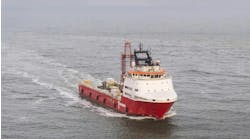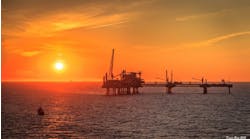Dev George
Houston
Boundary disputes and multi-national rivalry in West Africa
The southeastern Niger Delta has been a region under contention for centuries and, with its recognition as a major depository of hydrocarbon reserves, is even more so today. On the surface, it seems simply a question of national boundaries, but the competition of multinational oil companies for the area's oil and gas muddies the waters.
Nigeria, West Africa's richest country and principal petroleum producer, is one of the contestants in both of the current boundary disputes; the others are Cameroon and Equatorial Guinea. Nigeria's chief economic rival in the region is none of the small neighboring countries, most of which are French-speaking, but France itself, which retains very strong economic and cultural ties to its former colonies, the Francophone nations of West Africa, where Elf Aquitaine is the leading multinational operator.
Like many other regional disputes in Africa, these originate during the colonial period.
Under British rule, Nigeria added the northern part of Cameroon to its territory, and the southern Cameroon was held by Germany. After World War I, when German colonies were disolved, much of Cameroon was mandated to Britain as well. With independence in 1960, the two countries were divided once more, but the Bakassi Peninsula, was left in limbo, until the presence of oil was discovered 20 years ago.
Since that time, both Nigeria and Cameroon have claimed the oil-rich Bakassi Peninsula. Both countries have awarded oil leases in the area, and both countries have sent troups into the area that have sometimes clashed. Sporadic bursts of artillery gunfire are also occasionally felt in the Nigerian villages, south of Calabar, capital of Cross River.
During the 1967-70 Biafra civil war, France supported separatist Biafra and lost much of its influence in Nigeria as well as petroleum operations, when the nation was re-unified.
On and offshore, Cameroon has granted most of its leases to Elf, while Nigeria has spread leases among numerous major and independent operators.
In the World Court, where both countries have taken their cases for arbitration, Nigeria has maintained that Cameroon is being aggressive in Bakassi at the instigation of the French, with whom it has a military pact. On the table is the 20 year boundary issue with Cameroon over the Bakassi Penisula and its offshore Southeast Niger Delta, which is now proving so prospective.
In fact, even as the World Court is considering the Nigerian-Cameroon case, another border dispute has arisen - also due to the discovery of oil. The Mobil-UMC find in Equatorial Guinea's Block B of the Zafiro Field and its associated structures has led to a call for the determination of the Nigerian-Equatorial Guinean frontier between Block B and Nigeria's Block 102, which is held by Elf. [See last month's article on the Zafiro Field, page 46.]
In both cases we can see how the oil fortunes of a country can be tied to the business decisions of the majors. At another level we can see how the oil business is essentially a political business. In the Zafiro case, Mobil is setting up an entire oil industry in Equatorial Guinea, and that country's decision of whether or not to listen to Nigeria's claim to joint production is undoubtedly partly Mobil's decision as well. [Fred Akani contributed to this report.]
Privatization rejected in Mexico
The technocrats of Mexico's ruling Institutional Revolutionary Party (PRI), including President Ernesto Zedillo and his disgraced predecessor Carlos Salinas de Gortari have been soundly rejected by the rank and file of the party in its 17th national assembly, recently concluded in Mexico City. And with them have gone their failed policies that have been mired in scandal after scandal for almost a decade, including privatization of sectors of Mexico's petroleum industry.
Calling for a return to the ethics and morality of the PRI's founding principles, the party, led by the powerful oil workers union, voted to "defend" the nation's oil industry and abandon the privatization program set forth by Pemex, which was to begin with privatization of its petrochemical facilities. Although without legal standing, it is nevertheless likely to be at the forefront of Zedillo's upcoming policies.
In addition to rejecting privatization, the PRI, which has been loosing in local and state elections, adopted election reforms, as well, which will bring real democracy to Mexico if put into effect: the PRI's presidential candidate is to be elected rather than appointed by his predecessor, and must have held elective office before. Furthermore, women are to compose 30 percent of PRI's candidates.
Of course, the PRI could just be posturing in hope of garnering greater support among the generally unhappy populace. The next election will tell.
Boom driving US leases
For the second time in less than a year, a US government lease sale has drawn record bids and resulted in record awards. The first, earlier this year, turned attention solidly toward the deepwater tracks still awaiting development, and now the second, in September, has offered many of those premium tracks in the western Gulf of Mexico that operators had indicated they were interested in. As a consequence, this sale has netted bids with a total value of US$504 million, the highest received in a western US Gulf sale since 1983's all-time high of 1.5 billion.
Some 929 bids were received from majors and independents on 617 tracks off Texas and in the deepwaters off Louisiana. $352.5 million for the right to drill in the western Gulf.
The record-breaking sale was the direct result of the growing number of successful developments in the US Gulf's deepwater sector - successes due to growing technologies aimed at this aspect of exploration and a reduction in the costs of deepwater E&P. Of the 617 tracks offered, 433 were at depths over 200 meters, qualifying for royalty relief under the new government rules passed last November.
Maintaining its leader standing, Shell Offshore had 123 successful bids. Chevron followed with 51 and Texaco with 45.
Offshore soap
Will Bjorn be able to maintain his friendship with Erik despite Erik's playing up to Knut for a better position at Bjorn's expense? Can Bjorn keep his mind on his work on E deck knowing that Jon's in Stavanger with his girlfriend Inga? Will the crew be able to bring the new wells onstream on schedule even though the Huldra Platform has a record for early production?
All those stories and more are being broadcast to Norwegian TV viewers in the new soap, Offshore, which was aired for the first time in September. It tells the story of a fictional Norwegian North Sea facility and its crew in 36 episodes.
Reviews were mixed. So far, however, there's been no blowout.
Briefs. . .
Europe:
Norsk Hydro's Troll Oil subsea complex is the world's largest, with the addition of the next phase of its development and a second FPS. The complex has 18 wells in its oil province, 24 wells in the southern gas province, and 32 wells in the northern gas province. Some 74 subsea completions will eventually be operating. The total area is over 250 sq km.
Norway's Barents Sea Snohvit Field is to be developed by the year 2000, according to Statoil. The program to develop the arctic field is part of an effort to attract operator interest to the Norwegian Barents Sea development program.
Russia's Pechora Sea Varandey More Field, southwest of Novaya Zemlya, is to see further drilling in a joint effort by Statoil and Gazprom. Gazprom discovered the oilfield a year ago with a wildcat well. A second well is currently being drilled in the 15 meters water depth. Appraisal of commerciality continues.
Mideast:
Egypt's East Zeit oil concession in the Gulf of Suez, which produces 5,000 b/d, has been sold for US$74 million by operator Esso Suez to Seagull Energy. Proven reserves are estimated at 17 million bbl.
Qatar's Al-Rayyan Field is set to go into production right away and be up to its 30,000 b/d oil peak rate by yearend. The Arco-operated field was late in coming onstream due to construction delays on its production platform.
The first well on Azerbaijan's Chiraq Field has been spudded by the Dada Gorgud, formerly the Kaspmorneft semisubmersible. Drilled as the first of three appraisal wells by the Azerbaijan International Offshore Consortium (AIOC), the field is set to go on production next year with 24 wells producing 120,000 b/d oil.
Africa:
Côte d'Ivoire has signed its first deepwater production sharing contract. Block CI-105, the Etente block, covers 512,000 acres in 1,500-6,000 ft water. Shell Exploration Africa, the new operator, plans 3D seismic over the block before the end of the year.
The Congo's Girassol and Moho Fields, recently discovered by Elf, are set for appraisal and development over the next year and a half. Moho is extensively faulted and will likely be studied more before a program is decided, but Girassol, a single giant structure, will probably see fast-track development akin to nearby N'kossa.
Asia/Pacific:
The Philippines's Malampaya Field, in 900 meters of water, is to be developed via a subsea system rather than a TLP, as was originally planned. Shell International has decided to produce the field's 100 billion cubic meters of gas via a subsea production system tied to a shallow water processing platform some 25 km distant.
New Zealand's Northland Block is to see the drilling of an exploratory well within 18 months by Conoco and its partners Inpex and Todd Petroleum. The well is to be based on the most extensive seismic survey ever done in New Zealand, some 4,687 miles of 2D data. The Block, some 44,420 sq miles, has water depths up to 6,650 ft.
Western Australia's Laminaria and Corallina Fields are in a fast-track development program from Woodside Petroleum and partners BHP and Shell. Fabrication of an FPSO to serve both fields is to start in a few months, and contractors are being selected for the design and construction of components, processing facilities, mooring system, and subsea production systems for joint development.
Another large Western Australian gas reservoir has been discovered by Woodside with its 1A Lynx wildcat well. The find may hold as much as 10 tcf gas and lies near producing North Rankin and Goodwyn Fields. It could mean Woodside has proven its goal of 35 tcf gas in the region, enough to meet LNG contracts and extend new contracts into the 21st century.
Americas:
Brazil's Petrobras has just completed drilling its ultra-deep 6-MLS-3-RJS (Marlim Sul #3) appraisal well at a water depth of f1,709 meters, 125 km offshore in the Campos Basin. Tests indicate potential production of 5,000 b/d oil and 70,000 cm/d gas.
Copyright 1997 Oil & Gas Journal. All Rights Reserved.


